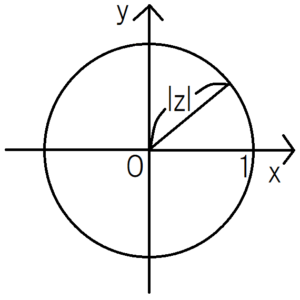[mathjax]
There are various kinds of methods of solving complex integrations, such as using the Cauchy’s integral theorem, the residue theorem or specifying a specific integration route. It is necessary to use the appropriate method for a complex integrations you want to solve. Of course, you should remember as many kinds of the methods as possible.
Reference: Cauchy-Riemann Equation and Holomorphic Function
Method of Using Cauchy’s Integral Theorem
Cauchy’s Integral Theorem
If the complex integral route \(C\) is a single closed curve and the function \(f(z)\) is holomorphic on the path \(C\) and its inside, the following expression holds.
$$\int_{C} f(z) dz=0$$
Practice
Calculate the complex integral:
$$\int_{|z|=1} z^3dz$$
What is a complex plane?
This integration needs to be considered on a complex plane. A complex plane is the plane coordinate with the real part of the complex number on the horizontal axis and the imaginary part on the vertical axis. The horizontal axis is the real axis, and the vertical axis is the imaginary axis.

Here, \( |z|=1\) on the complex plane represents a circle with a radius of \(1\) centered at the origin \(|z|=0\). Defining \(z\) as \(z≡x+iy\), the following equation is obtained by the Pythagorean theorem and the complex plane.
$$|z|=\sqrt{x^{2}+y^{2}}・・・(1)$$
Substitute \(z=1\) into the equation (1).
$$x^{2}+y^{2}=1$$
This equation obviously expresses a circle on the plane coordinate.
Using the Cauchy-Riemann equation to \(f(z)=z^3\), the function \(f(z)\) is holomorphic. Therefore, the complex integral is caluculated by the Cauchy’s integral theorem.
$$\int_{|z|=1} z^{3} dz=0$$
Method of Using Residue Theorem
Overview of Laurent Expansion
The Laurent expansion is what extend the Taylor expansion to negative powers.
$$f(z)=\sum_{n=-∞}^{∞} {a_{n}(z-α)^{n}}$$
Overview of Residue
The residue is the coefficient of \((z – α)^{- 1}\) of the Laurent series of \(f(x)\), that is, \(a_{-1}\) in the above equation of the Laurent expansion.
The residue of the function \(f(z)\) at \(z=α\) is expressed as
$$a_{-1}=Res(α,f(z)).$$
Residue Theorem
The residue theorem is expressed as
$$\int_{C} f(z) dz=2πi\sum_{j=1}^{k}Res(α_{j},f(z)).$$
Here, \(k\) represents the number of non-holomorphic points that the function \(f(z)\) has on the integral route \(C\) or its inside.
How to Obtain the Residue
In the previous section, we considered the case which the integral route and its interior are holomorphic with the Cauchy’s integral theorem. However, what if the integral route and its interior includes non-holomorphic points? In this case, the complex integrals can be obtained by the residue of \(f(z)\) at non-holomorphic points.
The residue \(Res(α,f)\) of the pole of order \(n\) of the function \(f(x)\) at \(z=α\) can be expressed as
$$Res(α,f)=\frac{1}{(n-1)!}\displaystyle \lim_{z \to α} \frac{d^{n-1}}{dz^{n-1}}(z-α)^{n}f(z).$$
For example, the residue \(Res(α,f)\) of the pole \(z=α\) of the order \(1\) of the function \ (f (z) \) expresses as
$$Res(α,f)=\displaystyle \lim_{z \to α} (z-α)f(z).$$
Practice 1
Calculate the complex integral:
$$(i) \ \int_{|z|=1} \frac{1}{z}dz$$
$$(ii) \ \int_{|z-5i|=1} \frac{1}{z}dz$$
(i)\(|z|=1\)
The non-holomorphic point of \(f(z)=\frac{1}{z}\) is only \(z=0\). Then \(z=0\) is the point inside the integration route \(|z|=1\). In addition, the residue is obviously \(1\).
Substitution the residue into the residue theorem to calculate the integration.
$$\int_{|z|=1} \frac{1}{z} dz=2πiRes(0,\frac{1}{z})=2πi・1=2πi$$
(ii)\(|z-5i|=1\)
\(|z-5i|=1\) is a circle whose center is at \((x, y) = (0, 5)\) on the complex plane and its radius is \(1\). The non-holomorphic point of \(f(z)=\frac{1}{z}\) is only \(z=0\), but this point is out of the circle \(|z-5i|=1\). Therefore, the function \(f(z)\) is holomorphic on this integral route and its inside, and the complex integration is 0.
$$\int_{|z-5i|=1} \frac{1}{z} dz=0$$
Practice 2
Calculate the complex integral:
$$\int_{|z+i|=1}f(z)=\frac{1}{z^{2}+1}$$
The function \(f(z)\) can be transformed as
$$f(z)=\frac{1}{z^{2}+1}=\frac{1}{(z+i)(z-i)}.$$
From this equation, there are two points \(f(z)\) is not holomorphic, that is, \(z=\pm i \). However, the point \(z=+i\) is out of the integration route \(|z+i|=1\), so it does not affect the integration result. Therefore, you only need to pay attention to the residues of the point \(z=-i\) within the integral route.
Using the formula for finding the residues above, find the residue for point \(z=-i\).
$$Res(-i,\frac{1}{z^{2}+1})=\displaystyle \lim_{z \to -i} (z+i)・\frac{1}{(z-i)(z+i)}=\displaystyle \lim_{z \to -i} \frac{1}{z-i}=-\frac{1}{2i}$$
From the above, the complex integration is obtained as follows.
$$\int_{|z+i|=1} \frac{1}{z^{2}+1} dz=2πi \left[ Res(-i,\frac{1}{z^{2}+1}) \right]=-2πi・\frac{1}{2i}=-π$$
Method of Setting an Integration Route
If you can set the integration route yourself, you become able to solve more kinds of complex integrations. For example, the real integration that can not be integrated with elementary functions can be extended to the complex integration and solved.
I’ll write the details later.